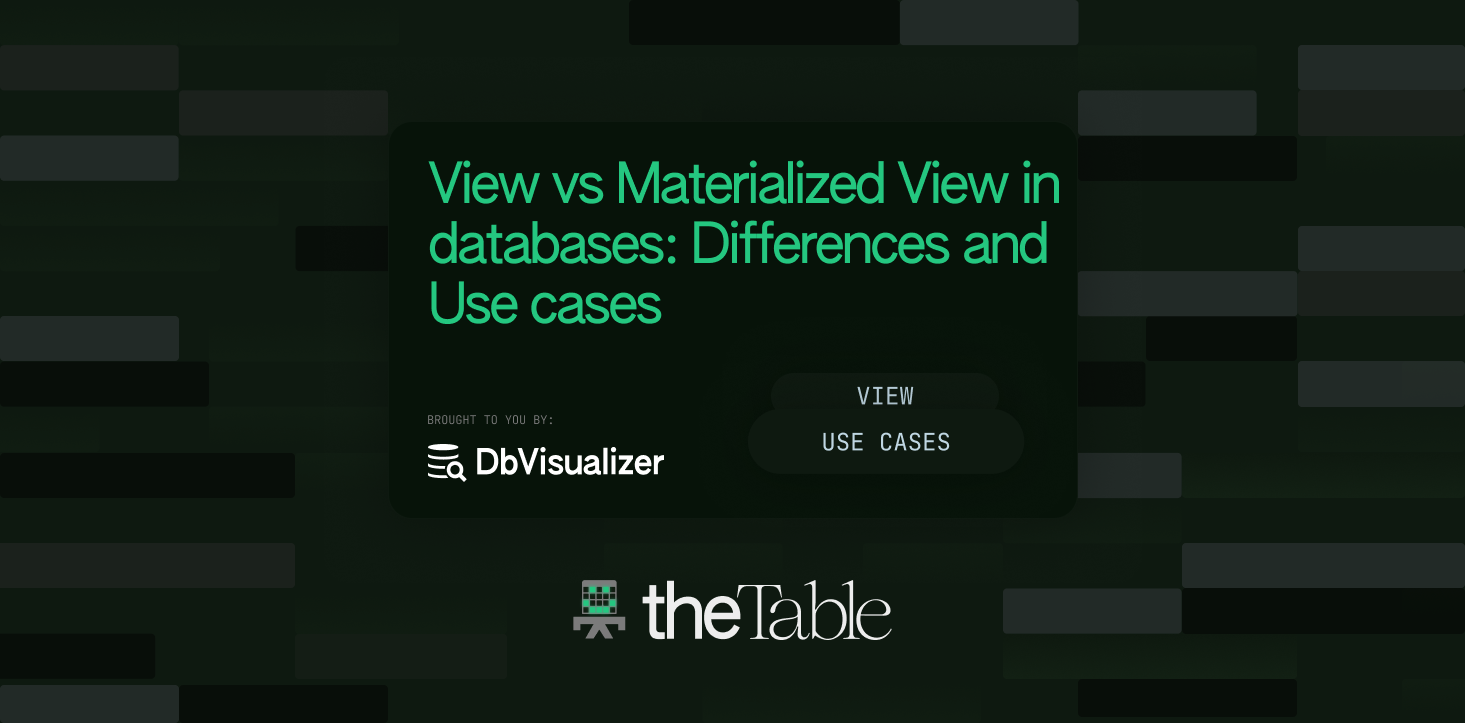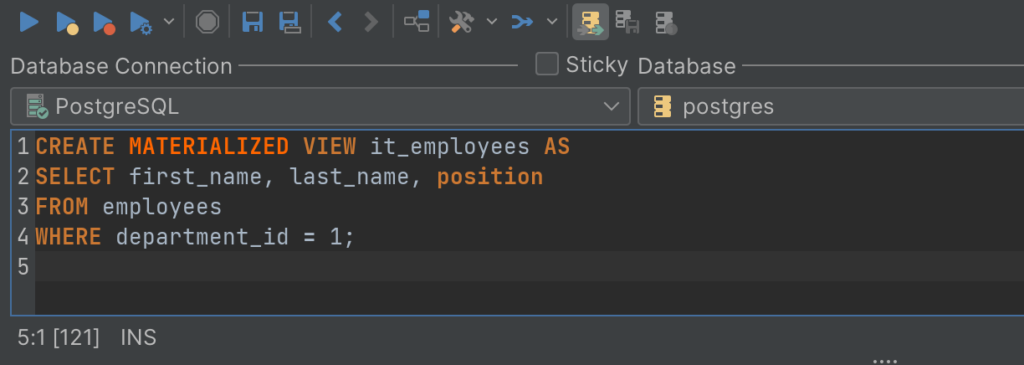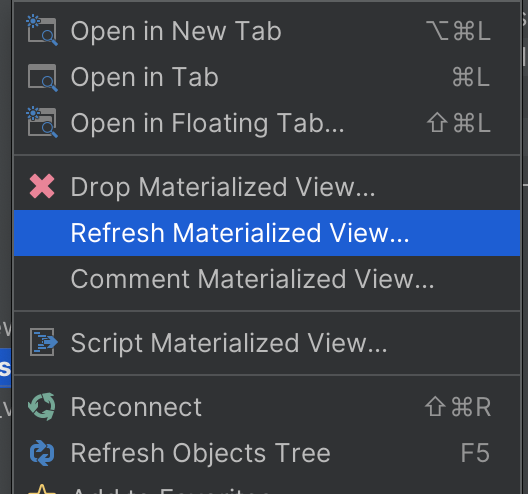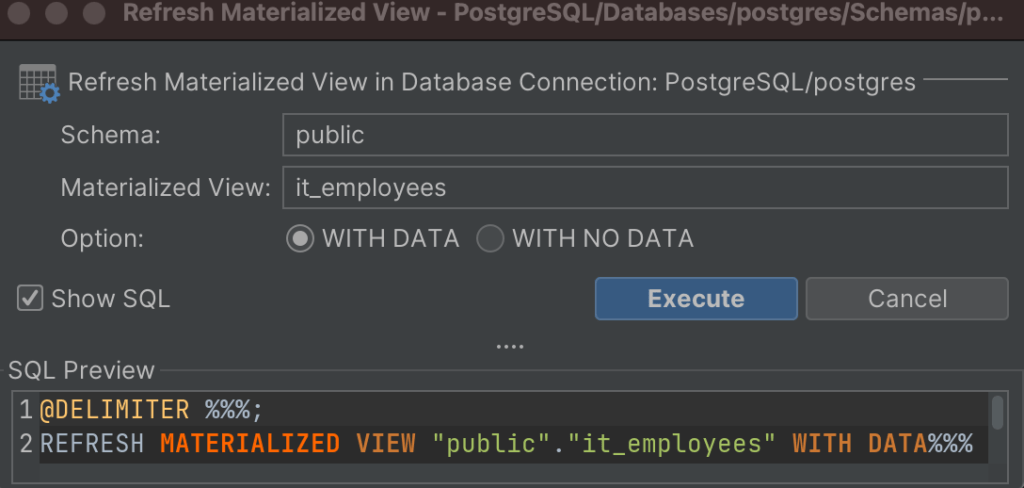PostgreSQL Materialized Views: A Beginner's Guide
 DbVisualizer
DbVisualizer
Uncover the power of PostgreSQL's Materialized Views with our beginner’s guide. Dive deep into optimization techniques, discover the vital role of DbVisualizer, and master the art of creating, managing, and refreshing views seamlessly. Whether you're a novice or a seasoned developer, this tutorial promises insights that can transform your data management game. Don't miss out on this essential read!
Tools used in this tutorial
DbVisualizer - top rated database management tool and SQL client.
The PostgreSQL database.
PostgreSQL is a robust open-source relational database management system known for its adaptability and features that enhance efficient data management, including Materialized Views. Unlike standard views, Materialized Views store query results physically, serving as a cache for high-speed data retrieval and are essential for optimizing complex queries and dashboard reporting.
This guide is tailored for both novice database enthusiasts and experienced DBAs, providing insights on managing PostgreSQL Materialized Views effectively. Dive in to explore their implementation and management.
When to Use Materialized Views
In the dynamic world of data management, ensuring efficient access and processing of data is paramount. Here's where Materialized Views shine. But when exactly should one opt for them? Let's delve deeper into their strategic applications.
Query Optimization
Executing a long-running query can be a test of patience for database enthusiasts. Materialized Views alleviate this issue significantly. They store the SQL query result physically, eliminating the necessity to recompute complex operations, and ensuring faster data retrieval. In essence, Materialized Views facilitate instant access to processed data, akin to having prepared results at hand, boosting efficiency and saving time.Data Warehousing
In the grand theater of data analytics, data warehousing plays a central role. The ETL (Extract, Transform, Load) processes, which stand foundational in warehousing, can often be cumbersome, especially when handling voluminous data. Enter Materialized Views. They seamlessly dovetail into the ETL processes, storing interim transformations and results. This not only accelerates the data integration process but also ensures that data storage is both efficient and readily accessible.Dashboard Reporting
In today's fast-paced business environment, real-time data visualization isn't just a luxury; it's a necessity. Dashboards need to reflect the most recent data to aid in quick decision-making. However, with growing datasets, ensuring instantaneous data rendering on dashboards can be challenging. Materialized Views come to the rescue by acting as pre-processed data caches. By using them, dashboards can swiftly fetch data, enhancing their responsiveness and ensuring that stakeholders always have their finger on the pulse of real-time insights.
Creating Materialized Views in PostgreSQL Using DbVisualizer
Crafting Materialized Views in PostgreSQL can appear complex initially, but with DbVisualizer, simplicity is assured. Ready to simplify the process? Here’s how we'll proceed:
1. Basic Syntax and Examples
The foundational step in mastering Materialized Views is understanding the basic syntax. Here’s a simple formula to remember:
1 CREATE MATERIALIZED VIEW view_name AS
2 SELECT column1, column2, ...
3 FROM table_name
4 WHERE condition;
Walkthrough:
Suppose you have a table named employees and you want to create a materialized view of all employees in the 'IT' department:
Create table employees:
1 CREATE TABLE employees (
2 employee_id SERIAL PRIMARY KEY,
3 first_name VARCHAR(50) NOT NULL,
4 last_name VARCHAR(50) NOT NULL,
5 email VARCHAR(100) UNIQUENOT NULL,
6 phone_number VARCHAR(15),
7 hire_date DATE NOT NULL,
8 position VARCHAR(100) NOT NULL,
9 salary DECIMAL(10, 2) NOT NULL,
10 department_id INT,
11 manager_id INT REFERENCES employees(employee_id)
12 );
Populate table employees with sample data:
1 INSERT INTO employees (first_name, last_name, email, phone_number,
hire_date, position, salary, department_id, manager_id) VALUES
2 ('John', 'Doe', 'john.doe@example.com', '123-456-7890',
'2023-01-15', 'Software Developer', 55000.00, 1, NULL),
3 ('Jane', 'Smith', 'jane.smith@example.com', '123-456-7891',
'2023-02-01', 'HR Specialist', 60000.00, 2, NULL),
4 ('Emily', 'Johnson', 'emily.johnson@example.com', '123-456-7892',
'2022-11-23', 'Department Manager', 75000.00, 1, 1),
5 ('Robert', 'Brown', 'robert.brown@example.com', '123-456-7893',
'2021-08-12', 'Software Developer', 52000.00, 1, 3),
6 ('Lucas', 'White', 'lucas.white@example.com', '123-456-7894',
'2020-03-18', 'QA Engineer', 54000.00, 1, 3);
Create a materialized view for the table employees:
1 CREATE MATERIALIZED VIEW it_employees AS
2 SELECT first_name, last_name, position
3 FROM employees
4 WHERE department_id = 1;
Voila! You've just created your first Materialized View.
2. Creating Materialized Views with Joins
Marrying data from different tables? Joins are your best friend. And, combining joins with materialized views can be a powerful way to pre-calculate and store complex relations.
Here are some techniques and best practices you can use:
Always be clear on the purpose of the join to prevent redundant data.
Use explicit JOIN types (INNER, LEFT, RIGHT, FULL) for clarity.
Example:
To create a view combining data fromemployeesanddepartmentstables:
1 CREATE MATERIALIZED VIEW employee_departments AS
2 SELECT e.first_name, e.last_name, d.department_name
3 FROM employees e
4 INNER JOIN departments d ON e.department_id = d.id;
3. Materialized Views with Aggregation Functions
Utilizing aggregation functions in Materialized Views is crucial for extracting valuable insights from your data. These functions, which include COUNT(), SUM(), and AVG(), are instrumental in performing various mathematical operations to process and analyze data.
Let's illustrate this with an example where we calculate the average salary within the IT department using the AVG() function. Consider the following query:
1 CREATE MATERIALIZED VIEW avg_it_salary AS
2 SELECT department, AVG(salary) AS average_salary
3 FROM employees
4 WHERE department = 'IT'
5 GROUP BY department;
In this query, we’re specifically focusing on employees in the IT department and calculating their average salary, then storing the result in a Materialized View for efficient and fast data retrieval.
How to Execute Materialized Views in DbVisualizer
Executing Materialized Views effectively is made simple with DbVisualizer. Below are the steps to follow for creating and managing your Materialized Views using this tool.
- Open DbVisualizer, provide your database connection details, and connect to your PostgreSQL database.

DbVisualizer connection window.
- Navigate to the SQL Commander, the play icon at the top left.
![]()
The create SQL commander tab icon.
- Paste your SQL script for creating the Materialized View.

Create materialized view query.
- Hit the 'Play' button. A success message will confirm the creation.

Query execution success message.
With DbVisualizer’s intuitive interface combined with the above SQL insights, managing Materialized Views becomes as easy as pie. Dive in and watch your database perform with newfound efficiency!
Operations on Materialized Views with DbVisualizer
DbVisualizer serves as an efficient tool for managing materialized views, making a typically complex task straightforward. With a combination of robust features and an intuitive interface, users can easily navigate and adapt to any changes in the database environment. In the following sections, we'll delve into the various operations you can perform on Materialized Views using DbVisualizer.
1. Altering a Materialized View
While materialized views store static data, there might come moments when you wish to change their structure or the underlying query itself. You can easily make these changes by running a query in DbVisualizer.
To rename a materialized view:
1 ALTER MATERIALIZED VIEW old_view_name RENAME TO new_view_name;
Note: In PostgreSQL, you can't directly alter the definition (the SQL query) of an existing materialized view. Instead, you'd typically create a new one or refresh it. But structural changes, like renaming the view, are permitted.
2. Dropping Materialized Views
Whether it's due to evolving requirements or data housekeeping, there might be times when you need to bid adieu to a materialized view.
To drop a materialized view, you can run the query below in DbVisualizer:
1 DROP MATERIALIZED VIEW view_name;
You can also use DbVisualizer’s interface like so:
- Locate the materialized view you intend to drop in the left-side database tree.

Locating the materialized view in the object's tree.
- Right-click on the desired view and select 'Drop'.

Drop materialized in the context menu.
- Confirm and execute the action in the pop-up window.

Confirm drop materialized view dialogue box.
3. Refreshing a Materialized View
Materialized views capture a static snapshot of a query result. However, when the underlying data changes, these views become outdated. To update them with the latest data, a refresh is needed since, unlike standard views, materialized views don’t automatically update.
To refresh your materialized view, use the query below:
1 REFRESH MATERIALIZED VIEW view_name;
You can also refresh your materialized view with DbVisualizer like so:
- Navigate to the materialized view you wish to refresh, right-click on the view, then choose the 'Refresh' option from the context menu.

Refresh materialized view in context menu.
- Confirm and execute the action in the pop-up window.

Confirm refresh materialized view dialogue box.
Great! You have successfully refreshed your materialized view.
Note: It is important to note that there are two methodologies to refresh a materialized view; incremental refresh and complete refresh. We previously discussed the incremental refresh, where only the changes since the last refresh are incorporated, typically making it a faster process. In contrast, the complete refresh involves completely rebuilding the view, and discarding the old snapshot to create a new one that reflects the current state of the underlying data.
Conclusion
As we come to the end of this tutorial, it's time to reflect on the intricate dance of data management and the role of tools like Materialized Views and DbVisualizer in streamlining this process. Let's take a moment to recap and ponder on our journey together.
We began with an introduction to PostgreSQL's prowess and dived deep into the concept of Materialized Views. These views, by physically storing query results, act as a catalyst in speeding up data retrieval operations, making them indispensable in certain scenarios.
Our exploration emphasized the strategic application of Materialized Views. Whether it's for query optimization, aiding in data warehousing, or enhancing dashboard reporting, they serve as a robust tool to ensure efficient and quick data access.
Throughout our journey, one companion remained consistent: DbVisualizer. This tool not only simplifies the creation of Materialized Views but also makes their management, from refreshing to monitoring, an intuitive and efficient process. The interface, combined with its array of features, stands as a testament to DbVisualizer's commitment to making database management user-friendly.
FAQs(Frequently Asked Questions)
What are Materialized Views in PostgreSQL?
Materialized Views in PostgreSQL are database objects that store the result of a query physically and provide indirect access to real table data, significantly speeding up complex query retrieval times. Unlike standard views, they don't reflect the latest data in the underlying tables unless refreshed.
How can DbVisualizer aid in managing PostgreSQL Materialized Views?
DbVisualizer offers an intuitive interface for creating, altering, refreshing, and monitoring Materialized Views in PostgreSQL. Its user-friendly tools simplify the management process, ensuring that views remain efficient and updated.
When should I consider using Materialized Views?
Materialized Views are particularly beneficial when you have complex queries that don't change often but take a long time to execute. They're ideal for query optimization, data warehousing, and enhancing dashboard reporting by caching data and reducing load on your main database.
How do I refresh Materialized Views in DbVisualizer?
In DbVisualizer, you can manually refresh a Materialized View by navigating to it using the database tree, right-clicking on the view, and choosing the 'Refresh' option. Additionally, DbVisualizer allows users to set up automatic refresh schedules for periodic updates.
Are there resources for advanced functionalities of DbVisualizer?
Absolutely! This tutorial provides an introduction, but for those looking to dive deeper into the advanced features and functionalities of DbVisualizer, many online repositories, forums, and official documentation are available. Always consider checking the official DbVisualizer website or related online communities for in-depth knowledge.
About the author
Ochuko Onojakpor is a full-stack Python/React software developer and freelance Technical Writer. He spends his free time contributing to open source and tutoring students on programming in collaboration with Google DSC.
Subscribe to my newsletter
Read articles from DbVisualizer directly inside your inbox. Subscribe to the newsletter, and don't miss out.
Written by

DbVisualizer
DbVisualizer
DbVisualizer is the database client with the highest user satisfaction. It is used for development, analytics, maintenance, and more, by database professionals all over the world. It connects to all popular databases and runs on Win, macOS & Linux.